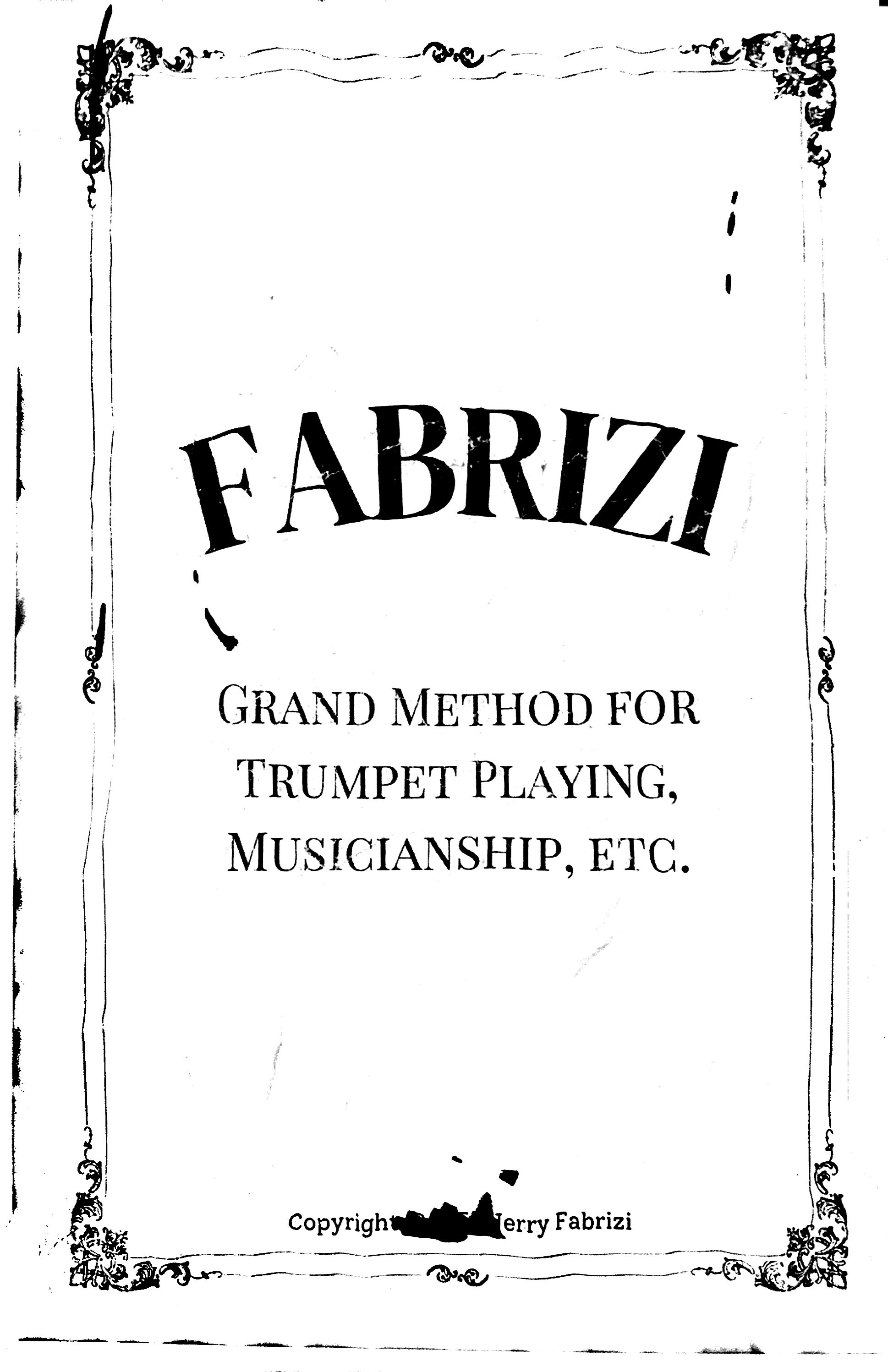Jerry Fabrizi's Grand Method for Trumpet Playing, Musicianship, Etc. - Introduction
Editor’s Note
Most trumpet players have considered Jerry Fabrizi’s Grand Method for Trumpet Playing, Musicianship, Etc. lost to history after his death in ████,1 along with most of his teachings. I’m very lucky to have unearthed sections of the book from a variety of sources, which I am currently editing and piecing together.
 Title page for the Grand Method, first and only edition
Title page for the Grand Method, first and only edition
About fifty copies of the Grand Method went into print, and so far I have found only six: three in the hands of former students of Fabrizi; one from Fabrizi’s estate, along with countless uncatalogued drafts, notes, and scribblings; one PDF in an anonymous Google Drive folder; and one in a Half Price Books near Cleveland, OH. Each of these copies is damaged or incomplete. Fabrizi was fond of tearing out and rearranging pages to better meet his students’ needs or to use as scrap paper. He clearly never considered the book finished and would contradict, cross out, or otherwise destroy entire sections over the course of his life. He would just as frequently contradict himself within the text itself, as if he was improvising the book as he went, never editing it before publication. At times he adopts the voice of a detached schoolmaster, addressing “the pupil” with deep seriousness; at other times, he breaks into rabid accusations, blaming “you” the reader for everything wrong with the state of trumpet playing today. Even the fundamentals of blare and tongue he presents in the Introduction below fall in and out of favor throughout the book (Chapter Seventeen, for example, claims that an itch at the back of the throat is the true foundation of masterful trumpet playing, and that the student should preface each practice session by gargling lawn grass clippings).
There is something inspiring in Jerry Fabrizi’s wild philosophy (or “anti-philosophy”) of trumpet. I persist in my quest to recover and restore the entirety of the Grand Method, and more is yet to come. It’s my hope that his teachings, however eccentric, can be of some use to anyone who didn’t have the privilege (some would say the misfortune) of knowing him in life.
Grand Method for Trumpet Playing, Musicianship, Etc., Introduction
Few things in life are as easy as playing the trumpet. This has led to a great many people, who have no business being behind the instrument, plaguing the rest of us with limp proclamations and fanfares, mere shadows of a trumpeter’s true calling. Why then write a treatise on the art of trumpet playing if it is already so accessible? Therein lies the very reason for such an intervention. Someone must stamp their foot and declare once and for all: Enough!
Where should we begin but with the most basic currency in which the trumpeter deals: the blare. Every child who holds a trumpet in their pudgy hands for the first time is a master in the art of blaring. The bovine groans and wails of the beginner trumpet player are among the most honest sounds one can make on the instrument: a primordial orgy from which all playing abstracts, whether lauded by critics or panned as tripe (most is deserving of the latter).
The other basic ingredient is the tongue. The word “tongue” may point to our organ for taste and oral manipulation, but it may also indicate the many languages of the world. Here I use the word “tongue” to refer to the multiplicity of styles, genres, and dialects in which the trumpeter can play. There are countless varieties of tonguing: hard tongue, soft tongue, hot tongue, dry tongue, short tongue, heavy tongue, plastongue, shrunk tongue, and, among the most challenging, west tongue. The tongue is the crucible which refines the blare and creates that ephemeral effect we call music.
Many trumpet teachers will say that the lips are yet another crucial component of trumpet playing. These so-called experts are fools and pretenders. Lips do not exist. The word is a distinction without a difference. What you have is a face, not lips. Watch any trumpet player worth listening to and you will immediately see that they play with the eyes, ears, and nostrils as much as they do with the borders of the oral cavity.
The pupil must understand that most writing and instruction on the trumpet and its history is fraudulent, about as useful as blowing into the wrong end of the trumpet—which, incidentally, comes much closer to excellent trumpet playing than anything most trumpeters are capable of these days.
I propose an alternative approach, one that begins from blare and tongue and works outwards, maintaining the primordial soup of chaos and animal sensibility from which all music (indeed, all life) begins. The greatest fumble that would-be trumpet players across history have made is believing that the trumpet is a noble instrument. It is not, and the sooner the pupil abandons this notion, the more they shall flourish. The feral trumpet player, armed with the sword of blare and the shield of tongue, announces the end of a sorrowful world and heralds the coming of a new age, ripe and writhing with possibility. I invite the pupil on this journey with me, and together we shall inherit Heaven on Earth.
-
Redactions at the request of █████████ ███████ and ████████ █████. ↩︎